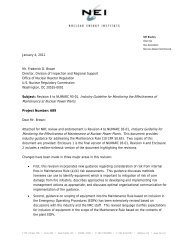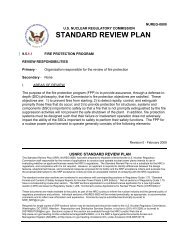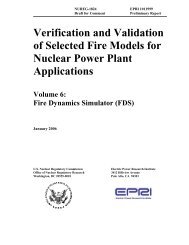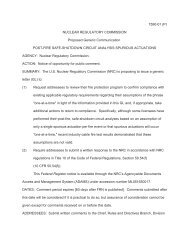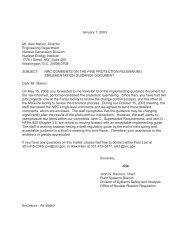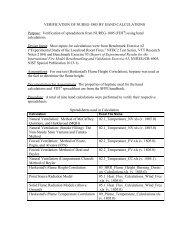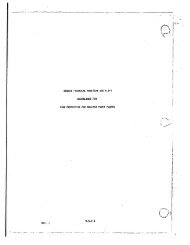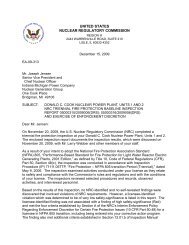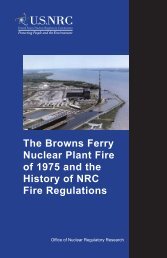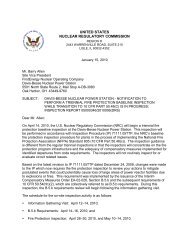NUREG/CR-6850, Volume 1 - NRC
NUREG/CR-6850, Volume 1 - NRC
NUREG/CR-6850, Volume 1 - NRC
You also want an ePaper? Increase the reach of your titles
YUMPU automatically turns print PDFs into web optimized ePapers that Google loves.
Conclusions and Closing Remarks3.3.5 Multiple Initiating Events from the Same Root CauseThis document offers an approach to qualitatively address those interactions resulting betweenfire and a seismic event; however, it does not discuss other combinations, for example, fires inconjunction with flooding. There is no evidence of such events occurring in the U.S. nuclearpower industry.3.3.6 Limitations in Internal Events Analysis that Carry Over to FireLimitations in current internal events analyses include full quantification of uncertainties,uncertainty in completeness of plant response model, errors of commission, and success criteria.These limitations are common to a Fire PRA as well. In addition, fire will introduce newchallenges in the area of uncertainty. For example, limitations to an analyst’s ability to predictthe physical behavior of a fire introduce uncertainties that go beyond those of internal eventsanalysis.3.3.7 Smoke DamageThe approach provided here is based on qualitative rather than quantitative estimates of smokeimpact. Fire test evidence exists to support the qualitative judgment for damage to electricalequipment excluding high-voltage equipment such as switchgear.3.3.8 Seismic/Fire InteractionsThe recommended approach includes a qualitative assessment of seismic/fire interactions in lieuof quantification. Seismic/fire interactions are expected to generally be of low risk importancegiven the seismic ruggedness requirements imposed on U.S. nuclear power facilities. The authorsalso note a lack of historical evidence of such problems in the nuclear industry.3.3.9 Administrative Aspects of the Fire Protection ProgramAspects of a plant’s administrative programs (e.g., training of operations staff, fire brigadepractices such as reliance on a brigade vs. a dedicated fire department, combustible controlsprograms, etc.) are issues that hold the potential to impact fire risk, but cannot be quantifiedgiven the current knowledge base. These issues will likely have some impact on plant-to-plantfire risk variability.3.3.10 Effectiveness of Fire Protection SystemsThe methodology described in this document relies on analyst judgment to assess theeffectiveness of fire detection and suppression systems in the context of a particular fire scenario.This approach weighs code compliance heavily in the effectiveness assessment. Nominally, acode compliant system is considered effective unless the analyst observes specific features that3-10





